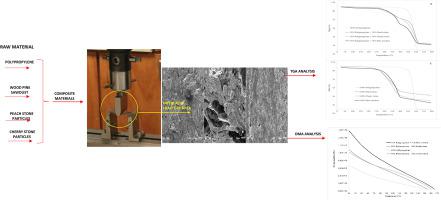Sustainable Materials and Technologies ( IF 8.6 ) Pub Date : 2021-05-27 , DOI: 10.1016/j.susmat.2021.e00300 Mario Núñez-Decap , Andrea Wechsler-Pizarro , Marcela Vidal-Vega

|
This study aimed to investigate the use of peach stone particles (PSP) and cherry stone particles (CSP) to manufacture composite materials with a polypropylene (PP) matrix.
A strong growth of processed fruit industry in Chile in the latter years has generated an increase of solid waste. Some of these residues are stones, stems, peels or others. Conversely, wood plastic composites (WPC) are materials that have been established in the international market, offering new alternatives of use for lignocellulosic by-products of the fruit industry.
The novel composites based in peach stones particles and cherry stone particles were compared to a wood plastic composite material manufactured with radiata pine sawdust particles with a polypropylene matrix (WSP-PP). The calorimetric (DSC), thermogravimetric (TGA) and thermomechanical (DMA) analysis, showed that properties of PSP-PP and CSP-PP composite materials were similar to WSP-PP.
PSP-PP presented similar mechanical and physical properties to WSP-PP, and CSP-PP the lowest ones. The penetration of the polypropylene matrix into the peach stone particles clearly improved the mechanical anchoring between PSP and PP. This good performance would favor the use of by-products of the fruit industry to elaborate composite materials. The properties of these new composite materials could be improved by adding compatibilizer agents or reinforcement fibers to obtain applications with an enhanced mechanical performance.
中文翻译:

桃子和樱桃核开发的聚丙烯复合材料的机械、物理、热和形态特性
本研究旨在研究使用桃石颗粒 (PSP) 和樱桃石颗粒 (CSP) 制造具有聚丙烯 (PP) 基体的复合材料。
智利加工水果行业在后几年的强劲增长导致了固体废物的增加。其中一些残留物是石头、茎、果皮或其他。相反,木塑复合材料 (WPC) 是已在国际市场上建立起来的材料,为水果行业的木质纤维素副产品提供了新的替代品。
将基于桃核颗粒和樱桃核颗粒的新型复合材料与由辐射松锯末颗粒和聚丙烯基质 (WSP-PP) 制成的木塑复合材料进行了比较。量热 (DSC)、热重 (TGA) 和热机械 (DMA) 分析表明,PSP-PP 和 CSP-PP 复合材料的性能与 WSP-PP 相似。
PSP-PP 的机械和物理性能与 WSP-PP 相似,而 CSP-PP 的机械和物理性能最低。聚丙烯基质渗透到桃石颗粒中明显改善了 PSP 和 PP 之间的机械锚固。这种良好的性能有利于使用水果工业的副产品来制作复合材料。这些新型复合材料的性能可以通过添加增容剂或增强纤维来改善,以获得具有增强机械性能的应用。











































 京公网安备 11010802027423号
京公网安备 11010802027423号